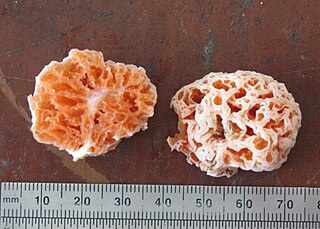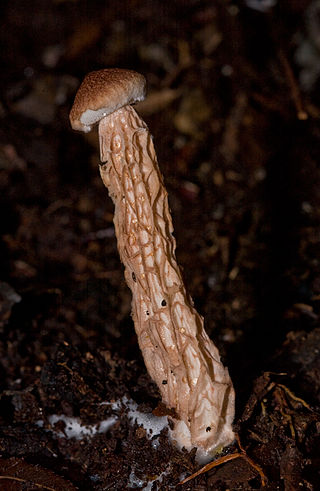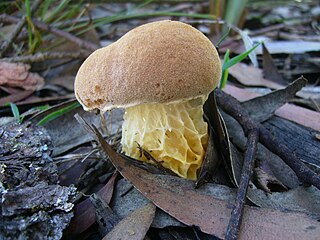
Amanita phalloides, commonly known as the death cap, is a deadly poisonous basidiomycete fungus, one of many in the genus Amanita. Originating in Europe, but later introduced to other parts of the world since the late twentieth century, A. phalloides forms ectomycorrhizas with various broadleaved trees. In some cases, the death cap has been introduced to new regions with the cultivation of non-native species of oak, chestnut, and pine. The large fruiting bodies (mushrooms) appear in summer and autumn; the caps are generally greenish in colour with a white stipe and gills. The cap colour is variable, including white forms, and is thus not a reliable identifier.

Edible mushrooms are the fleshy fruit bodies of several species of macrofungi. Edibility may be defined by criteria including the absence of poisonous effects on humans and desirable taste and aroma. Mushrooms that have a particularly desirable taste are described as "choice". Edible mushrooms are consumed for their nutritional and culinary value. Mushrooms, especially dried shiitake, are sources of umami flavor.

Flammulina filiformis is a species of edible agaric in the family Physalacriaceae. It is widely cultivated in East Asia, and well known for its role in Japanese and Chinese cuisine. Until recently, the species was considered to be conspecific with the European Flammulina velutipes, but DNA sequencing has shown that the two are distinct.

A bolete is a type of mushroom, or fungal fruiting body. It can be identified thanks to a unique cap. On the underside of the cap there is usually a spongy surface with pores, instead of the gills typical of mushrooms. A similar pore surface is found in polypores, but these species generally have a different physical structure from boletes, and have different microscopic characteristics than boletes. Many polypores have much firmer, often woody, flesh.

Suillus luteus is a bolete fungus, and the type species of the genus Suillus. A common fungus native all across Eurasia from Ireland to Korea, it has been introduced widely elsewhere, including North and South America, southern Africa, Australia and New Zealand. Commonly referred to as slippery jack or sticky bun in English-speaking countries, its names refer to the brown cap, which is characteristically slimy in wet conditions. The fungus, initially described as Boletus luteus by Carl Linnaeus in 1753, is now classified in a different fungus family as well as genus. Suillus luteus is edible, though not as highly regarded as other bolete mushrooms. It is commonly prepared and eaten in soups, stews or fried dishes. The slime coating, however, may cause indigestion if not removed before eating. It is often sold as a dried mushroom.

Coprinus comatus, commonly known as the shaggy ink cap, lawyer's wig, or shaggy mane, is a common fungus often seen growing on lawns, along gravel roads and waste areas. The young fruit bodies first appear as white cylinders emerging from the ground, then the bell-shaped caps open out. The caps are white, and covered with scales—this is the origin of the common names of the fungus. The gills beneath the cap are white, then pink, then turn black and deliquesce ('melt') into a black liquid filled with spores. This mushroom is unusual because it will turn black and dissolve itself in a matter of hours after being picked or depositing spores.

Macrolepiota procera, the parasol mushroom, is a basidiomycete fungus with a large, prominent fruiting body resembling a parasol. It is a fairly common species on well-drained soils. It is found solitary or in groups and fairy rings in pastures and occasionally in woodland. It is widespread in temperate regions of Eurasia and possibly North America. Further research is needed to confirm whether specimens found in North America are the same species.

Amanita xanthocephala, known as the vermilion grisette, pretty grisette or vermilion amanita is a colourful mushroom of the genus Amanita. It is found in Australia in association with Eucalyptus and may be toxic to humans.

Omphalotus nidiformis, or ghost fungus, is a gilled basidiomycete mushroom most notable for its bioluminescent properties. It is known to be found primarily in southern Australia and Tasmania, but was reported from India in 2012 and 2018. The fan or funnel shaped fruit bodies are up to 30 cm (12 in) across, with cream-coloured caps overlain with shades of orange, brown, purple, or bluish-black. The white or cream gills run down the length of the stipe, which is up to 8 cm (3 in) long and tapers in thickness to the base. The fungus is both saprotrophic and parasitic, and its fruit bodies are generally found growing in overlapping clusters on a wide variety of dead or dying trees.

Austroboletus is a genus of fungi in the family Boletaceae. The widely distributed genus contains species that form mycorrhizal relationships with plants.

Macrolepiota clelandii, commonly known as the slender parasol or graceful parasol, is a species of mushroom-forming fungus in the family Agaricaceae. The species is found in Australia and New Zealand, where it fruits singly or in small groups on the ground in eucalypt woodlands, parks, and roadsides. It is a tall mushroom up to roughly 20 cm (8 in), with a broad cap covered with distinctive rings of dark brown scales. The whitish gills on the cap underside are closely spaced and free from attachment to the slender stipe, which has a loose ring on its upper half, and a bulbous base. The edibility of the mushroom is not known with certainty, but closely related parasol mushrooms are edible and some are very sought after.

Spongiforma is a genus of sponge-like fungi in the family Boletaceae. Newly described in 2009, the genus contains two species: S. thailandica and S. squarepantsii. The type species S. thailandica is known only from Khao Yai National Park in central Thailand, where it grows in soil in old-growth forests dominated by dipterocarp trees. The rubbery fruit bodies, which has a strong odour of coal-tar similar to Tricholoma sulphureum, consists of numerous internal cavities lined with spore-producing tissue. S. squarepantsii, described as new to science in 2011, is found in Malaysia. It produces sponge-like, rubbery orange fruit bodies with a fruity or musky odour. These fruit bodies will—like a sponge—resume their original shape if water is squeezed out. The origin of the specific name derives from its perceived resemblance to the cartoon character SpongeBob SquarePants. Apart from differences in distribution, S. squarepantsii differs from S. thailandica in its colour, odour, and spore structure.
Roy Edward Halling is an American mycologist.

Amanita ochrophylla is a fungus of the family Amanitaceae native to southeastern Australia. Its large and distinctive buff fruit bodies are common after rainfall.

Austroboletus rarus is a species of bolete fungus in the family Boletaceae. Found in Singapore and Australia, it was described as new to science by E.J.H. Corner in 1972, who called it Boletus rarus. Corner found the type collection growing on a forest floor in Bukit Timah in December 1940. He suggested that it might be a variety of Boletus rubiicolor. Egon Horak transferred it to the genus Austroboletus in 1980.

Austroboletus lacunosus is a bolete fungus native to Australia.

Austroboletus eburneus is a species of bolete fungus found in Australia. It was described as new to science in 1986. The species name eburneus is the Latin adjective "ivory-white".

Austroboletus subflavidus is a species of bolete fungus in the family Boletaceae. It is found in eastern North America, where it fruits near oak and pine trees. Originally described as a species of Tylopilus by American mycologist William Murrill in 1938, it was transferred to the genus Austroboletus by Carl B. Wolfe in 1980. The fruit body has a white to yellowish convex to flattened cap measuring 3–10 cm (1.2–3.9 in) in diameter. The pores on the cap underside, which measure about 1 mm wide, are initially white to grayish before becoming pinkish. The coarsely reticulate and pitted stipe measures 4.5–14.5 cm (1.8–5.7 in) long by 0.7–3 cm (0.3–1.2 in). The spore print is reddish brown; spores are spindle-shaped (fusoid) with dimensions of 15–20 by 6–9 μm.

Austroboletus occidentalis, commonly known as the ridge-stemmed bolete, is a species of bolete fungus found in Australia. It was described as new to science in 1986 by mycologists Roy Watling and Norma M. Gregory. The species name occidentalis is derived from the Latin occidens "west"..
Austroboletus olivaceoglutinosus is a species of bolete fungus found in Sikkim in northeast India. It is so named for its sticky olive-green cap.

















